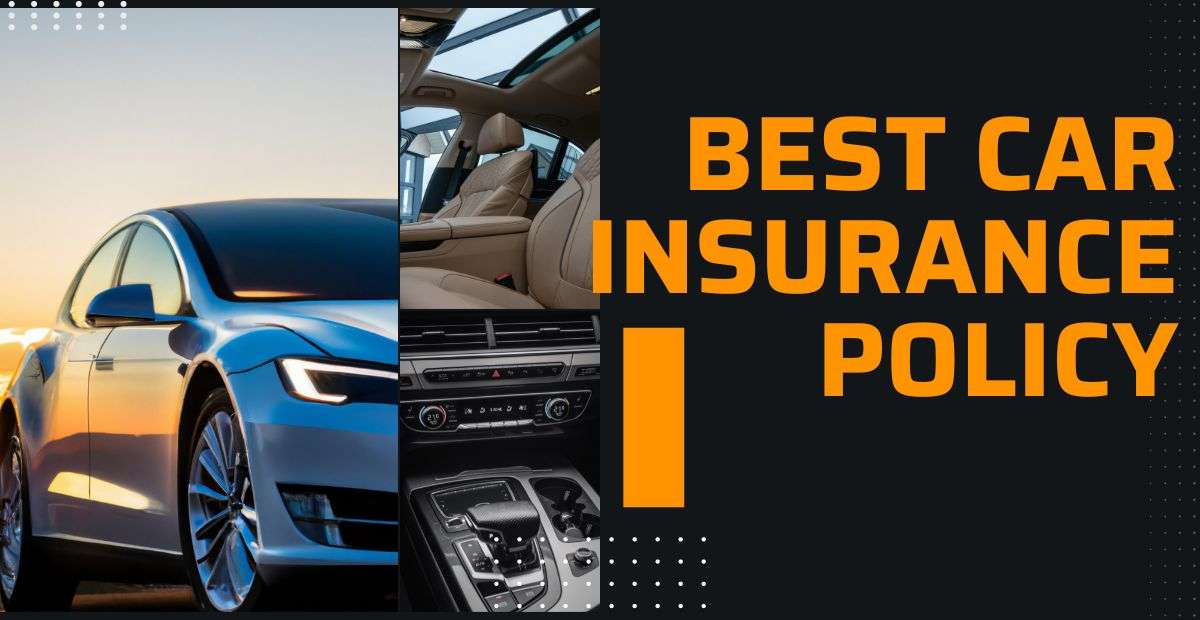Contents
Best Car Insurance Policy
1.Introduction
In today’s fast-paced world, having the right car insurance policy is essential to protect yourself and your vehicle from unexpected events. With so many options available, finding the best car insurance policy can be daunting. This comprehensive guide will provide you with eye-opening advice and insights into powerful car insurance policies, helping you make informed decisions for your coverage needs.

Table of Contents
- Introduction to Powerful Car Insurance Policies
- Understanding the Importance of the Best Car Insurance Policy
- Key Factors to Consider When Choosing Car Insurance
- Exploring Different Types of Car Insurance Coverage
- Tips for Finding the Best Car Insurance Policy
- Comparing Car Insurance Quotes: A Step-by-Step Guide
- The Future of Car Insurance: Trends and Innovations
- Conclusion: Making Informed Decisions for Your Car Insurance
Understanding the Importance of the Best Car Insurance Policy
- Protecting Your Assets: Safeguard your investment with comprehensive coverage.
- Financial Security: Avoid hefty expenses from unexpected accidents or damages.
- Legal Compliance: Fulfill legal requirements to drive on public roads.
- Peace of Mind: Drive with confidence knowing you’re covered for unforeseen events.
- Risk Management: Mitigate risks associated with vehicle ownership and usage.
In a world filled with uncertainties, having the best car insurance policy is not just a choice but a necessity. It’s your shield against financial turmoil and legal repercussions, offering a safety net in times of need. From protecting your assets to ensuring legal compliance and providing peace of mind, the importance of a robust car insurance policy cannot be overstated.
Key Factors to Consider When Choosing Car Insurance
- Coverage Options
- Consider comprehensive, collision, liability, and uninsured motorist coverage.
- Deductibles
- Choose deductibles that align with your budget and risk tolerance.
- Premiums
- Compare premium rates from multiple insurers for affordability.
- Customer Service
- Evaluate customer reviews and support quality for peace of mind.
- Insurer Reputation
- Research insurer ratings, financial stability, and claims processing reputation.
- Discounts Available
- Inquire about discounts for safe driving, multiple policies, and more.
- Policy Flexibility
- Look for policies with flexible terms and coverage adjustments.
- Claims Process
- Understand the claims process and insurer responsiveness during emergencies.
- Coverage Limits
- Ensure coverage limits meet your asset protection and legal requirements.
- Additional Benefits
- Explore added perks like roadside assistance, rental car coverage, and more.
- Policy Exclusions
- Review policy exclusions to avoid surprises during claims.
- Renewal Terms
- Understand renewal terms, rate changes, and policy adjustments over time.
Choosing the right car insurance policy involves weighing these factors carefully. Coverage options should match your needs, deductibles should be manageable, and premiums should fit your budget. Customer service and insurer reputation play vital roles in a smooth claims experience. Seek discounts and flexible policies while understanding coverage limits, exclusions, and renewal terms for long-term satisfaction.
Exploring Different Types of Car Insurance Coverage
Types of Car Insurance Coverage
- Liability Coverage Protects you from financial responsibility for injuries and property damage.
- Collision Coverage Covers repairs to your car after an accident, regardless of fault.
- Comprehensive Coverage Protects against non-collision incidents like theft, vandalism, and natural disasters.
- Uninsured/Underinsured Motorist Coverage Covers damages if you’re hit by an uninsured or underinsured driver.
- Medical Payments Coverage Pays for medical expenses resulting from a car accident, regardless of fault.
- Personal Injury Protection (PIP) Covers medical bills, lost wages, and other expenses for you and your passengers.
Understanding Each Coverage Type
- Liability Coverage protects others, not you.
- Collision Coverage pays for car repairs post-accident.
- Comprehensive Coverage includes theft, vandalism, and natural disasters.
- Uninsured/Underinsured Motorist Coverage safeguards against others’ lack of insurance.
- Medical Payments Coverage handles medical costs from accidents.
- Personal Injury Protection (PIP) provides broader coverage for injuries.
Choosing the Right Coverage
- Assess your needs before choosing coverage.
- Consider state requirements and your vehicle’s value.
- Evaluate deductible options for cost-effectiveness.
- Include additional coverage for comprehensive protection.
- Review policy details and exclusions carefully.
Understanding different car insurance coverage types helps you make informed decisions for optimal protection on the road. Choose wisely based on your needs, budget, and the level of coverage required in your area.
Tips for Finding the Best Car Insurance Policy
- Evaluate Your Coverage Needs: Assess your driving habits and vehicle type.
- Compare Multiple Quotes: Request quotes from different insurers for comparison.
- Consider Coverage Options: Look for comprehensive coverage tailored to your needs.
- Review Deductibles and Premiums: Balance between deductible amounts and premium costs.
- Check Insurer Reputation: Research customer reviews and ratings for reliability.
- Explore Discounts: Inquire about available discounts for safe driving or bundling policies.
- Understand Policy Details: Read and understand the terms, exclusions, and conditions.
- Ask Questions: Clarify any doubts with the insurer before finalizing the policy.
- Seek Professional Advice: Consult with an insurance agent for personalized recommendations.
- Monitor Policy Changes: Stay informed about updates or changes in your policy.
Finding the best car insurance policy involves thorough research, comparison, and understanding of your coverage needs. By following these tips, you can make informed decisions and secure the right protection for your vehicle and yourself.
Comparing Car Insurance Quotes: A Step-by-Step Guide
- Understanding Your Coverage Needs Determine what coverage types and limits suit your situation.
- Gather Quotes from Multiple Insurers Request quotes from at least three different insurance companies.
- Review and Compare Coverage Options Analyze each quote’s coverage details, deductibles, and exclusions.
- Consider Customer Service and Reputation Research each insurer’s customer reviews, ratings, and claims handling.
- Identify Discounts and Special Offers Look for discounts based on your driving record, safety features, etc.
- Evaluate Premiums and Payment Options Compare premium costs and choose a payment plan that fits your budget.
- Check for Policy Flexibility and Add-Ons Ensure the policy allows for adjustments and offers optional coverage add-ons.
- Seek Clarifications and Ask Questions Contact insurers for any clarification on policy terms and conditions.
- Factor in Long-Term Benefits and Stability Consider an insurer’s financial stability and long-term benefits.
- Make an Informed Decision Choose the car insurance policy that provides adequate coverage at a competitive price.
Comparing car insurance quotes can be simplified by following these step-by-step guidelines. This detailed process helps you make an informed decision that aligns with your coverage needs and budget.

The Future of Car Insurance: Trends and Innovations
The future of car insurance is evolving with innovative trends. Telematics, AI-driven claims, and usage-based insurance are reshaping policies. These advancements offer personalized coverage, streamlined claims processes, and cost savings. Telematics devices track driving behavior, rewarding safe practices. AI streamlines claims with faster processing and accuracy. Usage-based insurance adjusts premiums based on actual driving habits. These trends enhance customer experiences, improve risk assessment, and promote safer driving. As technology continues to advance, car insurance will become more tailored, efficient, and accessible for drivers.
Conclusion: Making Informed Decisions for Your Car Insurance
In making informed car insurance choices, thorough research is essential. Understanding coverage options, comparing quotes, and considering discounts help. Analyzing insurers’ reputations, customer service, and financial stability is crucial. Emerging trends like usage-based insurance and AI-driven claims processing influence decisions. Ultimately, the goal is comprehensive protection without compromising affordability. With careful consideration and informed choices, finding the best car insurance policy becomes achievable.


Hello, everyone!
This is unbelievable!
[url=https://bl4nkcode.info/]is bl4nkcode legit[/url]
See you later!
Hi, guys!
I can’t belive my eyes!
[url=https://bl4nkcode.info/]bl4nkcode legit resource[/url]
Catch you later!
Hey there, folks!
No way!
[url=https://bl4nkcode.info/]is bl4nkcode legit[/url]
Catch you later!
{ {บทความนี้เขียนได้{ยอดเยี่ยม|ดีมาก},
{ขอบคุณสำหรับข้อมูล|ขอบคุณที่แบ่งปัน}!|{ชอบมุมมองของคุณ|มุมมองของคุณน่าสนใจจริงๆ},
{ให้แง่คิดใหม่ๆ กับฉัน|มีข้อมูลใหม่ที่ฉันไม่เคยรู้มาก่อน}.|นี่คือสิ่งที่ฉันกำลังมองหา, {เป็นบทความที่มีประโยชน์มาก|ช่วยตอบคำถามที่ฉันสงสัยได้มาก}!|{คุณแนะนำหนังสือเพิ่มเติมเกี่ยวกับหัวข้อนี้ได้ไหม|มีหนังสืออะไรที่คล้ายกับเรื่องนี้แนะนำบ้าง}?|{ฉันเห็นด้วยกับความคิดเห็นของคุณ|ความคิดเห็นของคุณน่าสนใจ},
และ{อยากอ่านบทความเพิ่มเติม|อยากเห็นเนื้อหาเพิ่มเติมจากคุณ}.|{ข้อมูลที่น่าสนใจมาก|ข้อมูลนี้ใหม่มากสำหรับฉัน},
{เพิ่งเริ่มสนใจเรื่องนี้|มันทำให้ฉันอยากศึกษาเพิ่มเติม}.|มีข้อแนะนำเพิ่มเติมจากสิ่งที่คุณพูดในบทความนี้ไหม?|นี่เป็นครั้งแรกที่ฉันได้ยินเรื่องนี้, {อยากเรียนรู้เพิ่มเติมจริงๆ|อยากทำความเข้าใจมากขึ้น}.|มันทำให้ฉันนึกถึงประสบการณ์ของตัวเอง{ที่เกี่ยวข้อง|}.|บทความนี้{เปิดมุมมองใหม่ๆ ให้ฉันได้มาก|มีข้อมูลที่น่าติดตามจริงๆ}.|{น่าสนใจมากครับ|ข้อมูลนี้ดีมากครับ}, {ขอบคุณที่ให้ความรู้|ขอบคุณสำหรับข้อมูลครับ}.|{ชอบวิธีการนำเสนอของคุณ|การนำเสนอของคุณเข้าใจง่าย}, {มันชัดเจนและตรงประเด็น|มันทำให้เข้าใจได้ง่ายจริงๆ}.|สิ่งนี้ช่วยโปรเจ็กต์ของฉันได้มาก, {ขอบคุณครับ|ขอบคุณมากจริงๆ}.|{อยากได้ยินความคิดเห็นจากคนอื่นๆ เพิ่มเติม|ใครมีความคิดเห็นเพิ่มเติม} เกี่ยวกับเรื่องนี้?|{หัวข้อนี้สำคัญและควรถูกพูดถึงมากขึ้น|มันเป็นหัวข้อที่ควรได้รับการพูดถึง}.|{มีคำแนะนำเพิ่มเติมจากที่คุณเขียนไหม|ช่วยขยายความเกี่ยวกับเรื่องนี้ได้ไหม}?|{บทความนี้น่าสนใจ|เนื้อหาน่าติดตามจริงๆ}, {ให้แง่มุมที่ไม่เคยนึกถึง|ทำให้ฉันคิดในมุมใหม่ๆ}.|{อยากอ่านบทความเพิ่มเติมเกี่ยวกับเรื่องนี้|หวังว่าจะได้เห็นเนื้อหาเพิ่มเติมเกี่ยวกับหัวข้อนี้}.|{จะดีถ้าเพิ่มเติมเรื่อง…ในบทความนี้ด้วย|ถ้ารวมเรื่อง…ไว้ในบทความนี้จะสมบูรณ์มากขึ้น}.|{คุณเขียนได้ชัดเจนมาก|คำอธิบายของคุณยอดเยี่ยม}, {ติดตามผลงานของคุณต่อไป|รออ่านบทความถัดไปของคุณ}.}
Here is my web site: https://pgslot2.sh/
Greetings, all!
Found some great advice on managing finances and loans—take a look!
[url=https://cashmum-review.com/]Money-saving insights[/url]
Stay savvy with your money!